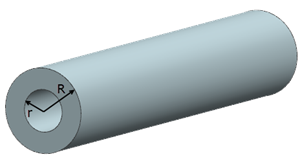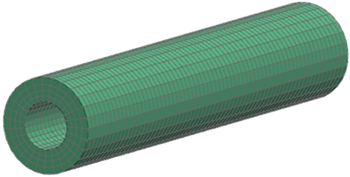VVT21 - Hollow cylinder with heat generation
| Solution | Test case |
|---|---|
| Finite volume method | SVTEST221 |
| Finite element method | SVTEST220 |
Description
This validation case examines a cylindrical model with heat generation. It compares the nodal temperature computed by the thermal solver using the finite element method and the finite volume method with analytical results.
Geometry
The geometry consists of a hollow cylinder with the outside radius of R = 0.1 m, inside radius of r = 0.05 m, and a length of L = 1 m.

Simulation model
The cylinder is meshed with a 3D swipe mesh with a parabolic hexahedron element type and a 15 mm element size.

The meshed elements have the following material and physical properties:
- Mass density: ρ= 2794 kg/m3
- Thermal conductivity: k= 0.1 W/m·K
- Specific heat at constant pressure: Cp = 880 J/kg·K
The following boundary conditions are applied:
- Temperature constraint on the outside of the cylinder with a value of To= 600 K.
- Thermal Loads: Heat Generation on the inside and outside of the cylinder with a value of q''= 100 W/m3.
- Thermal Convecting Zone on the inside of the cylinder with water as the fluid material, a temperature of 293 K, and a heat transfer coefficient of 100 W/m2·K.
This model uses the Simcenter 3D Multiphysics solver.
The following solution options are set:
- Solution Control: set the Element Discretization to Finite Element Method in the Thermal Solution Parameters modeling object for the finite element method.
Theory
The temperature distribution associated with radial conduction through a hollow cylinder is given by:
The solution to this differential equation is given by:
The coefficient α1 at r=r0 is obtained as follows:
The coefficient α2 at r=r1 is obtained as follows:
Results
The following table compares the nodal temperature results for the finite volume and finite element methods computed by the thermal solver with the analytical solution.
| Finite volume method | Finite element method | ||||
|---|---|---|---|---|---|
| Radius (m) | Ttheory (K) | T(K) | ΔT (K) | T(K) | ΔT (K) |
| 0.05 | 301.638 | 309.6216 | 7.9836 | 301.6899 | 0.0519 |
| 0.056 | 349.3943 | 353.2333 | 3.8390 | 349.3325 | 0.0618 |
| 0.062 | 392.3579 | 396.8451 | 4.4872 | 392.3948 | 0.0369 |
| 0.067 | 428.9601 | 432.0529 | 3.0928 | 428.8935 | 0.0666 |
| 0.073 | 462.6674 | 467.2607 | 4.5933 | 462.5236 | 0.1438 |
| 0.079 | 498.9637 | 502.0271 | 3.0634 | 498.7341 | 0.2296 |
| 0.085 | 532.3957 | 536.7936 | 4.3979 | 532.1028 | 0.2929 |
| 0.093 | 567.7281 | 568.3967 | 0.6686 | 567.4921 | 0.2360 |
| 0.1 | 600.0000 | 600.0000 | 0.0000 | 600.0000 | 0.0000 |
The maximum temperature difference between the analytical solution and the finite volume method is 7.9836 K, while the finite element method is 0.2929 K.
